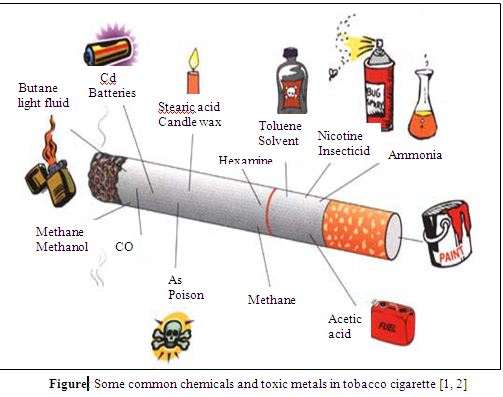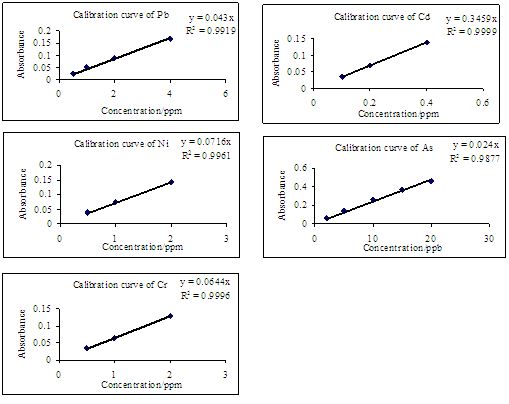Tobacco is an agricultural product processed from the leaves of plants in the genus Nicotinna. Before the revolutionary discover of the chemicals present in tobacco, it has been used as a smoking, pesticides and in some medicines (nicotine tartrate). Now, tobacco may be used in two forms: (a) smoking tobacco (cigarette, bidi, etc.) (b) smokeless tobacco or chewing tobacco (tamac, gul, zarda etc.). Inherently some of the most common toxic chemicals such as nicotine, toluene, hydrocarbon, ammonia, benzene etc. and toxic metals such as As, Cd, Ni, Hg etc. are present in tobacco. Some of the common chemicals present in tobacco. The presence of toxic metals in tobacco mainly depends on the toxic metals content in soil where the tobacco is cultivated. The use of fertilizer for cultivation of tobacco is one of main causes to increase the level of toxic metals (As, Hg, Pb, Cd, Cr, Ni, Se etc.) in soil. The tobacco plant is amenable to absorb and accumulate these heavy metal species from the soil into its leaves.
Usually, cigarette is made up of tobacco, paper and additives. As much as 600 – 1400 additives are used in cigarette manufacture. Many of these additives contain heavy metals such as Hg, Cd and Pb. Cigarette smoke contains particles and gases generated by the combustion of its various components at high temperature and hence create environmental contamination. More than 4000 compounds have been identified in environmental tobacco smoke, many of the same chemicals that are present in the smoke inhaled by smokers. Non-smokers when are exposed to the tobacco smoke is a known health hazards, they are secondhand smokers. Secondhand smoke is composed of two different parts (i) mainstream smoke (the smoke that a smoker breathes in and exhales) and (ii) side stream smoke (the smoke that comes off the burning end of a cigarette). Because side stream smoke is generated at lower temperatures and under different conditions than mainstream smoke, it contains higher concentrations of many of the toxins found in cigarette smoke. In addition, side steam smoke does not pass though filters, unlike some mainstream smoke, depending on the type of cigarette. Nearly 85% of the smoke in a room results from side stream smoke. The cigarette smoke can be inhaled directly by the smoker and non-smokers in cigarette-contaminated environment. Both main smokers and secondhand smokers are affected by the carcinogenic chemicals of smoke. Smoking delivers heavy metals to the lungs, particularly more volatile metals such as Cd, Hg, Ni or metal compounds such as nickel carbonyl that partition preferentially into the smoke phase on combustion. Some of these readily pass into the bloodstream and may accumulate in specific organ.
Tobacco (cigarettes and other tobacco products) is one of the biggest sources of nickel exposure for general population. Long term inhalation of nickel or nickel compound (e.g. nickel carbonyl) which is produced in smoke of tobacco during smoking may accumulate in larynx of throat and lung. These are potential cause for throat cancer, asthma and inflammation of sinuses.
Toxic metals that are present in tobacco can directly influence behavior by impairing mental and neurological function, influencing neurotransmitter production and utilization, and altering numerous metabolic processes. Thus the use of tobacco in cigarette causes devastating physical and environmental problems throughout the world.
Bidis are popular in lower income group people of Bangladesh. Bidi smoke delivers similar or higher levels of nicotine, cancer-causing chemicals and toxic metals to smokers than cigarettes. Bidis are considered more harmful to health than regular cigarettes because bidi contains unprocessed raw leaves of tobacco.
The chewing tobacco forms used in Bangladesh are similar to those commonly used in other south Asian countries. Chewing tobacco e.g. zarda, gul and tamac are made of a moist or dry chewing tobacco mixed with variety of colouring spice essence and perfumes. Some of these products, such as zarda is used in conjunction with paan (betel quid which is combination of betel leaf, areca nut and lime paste) and are individually made to one’s own taste. So, the ingredients of chewing tobacco are different. These are more harmful than the cigarette, because the whole toxic substances may enter into the human body. In this way, both smoking and smokeless tobacco creates a major health problem in users and nonusers.
Toxic metals (Ni, Pb, Cd, Hg, As etc.) are stable elements (they cannot be metabolized by the body) and bio-accumulative (passed up the food chain to humans). These metals along with many carcinogenic compounds may enter into human body through smoking and smokeless tobacco. As mentioned above, toxic metals have dangerous physiological affects on smokers and non-smokers. Hence, it is worth to analyze quantitatively the contents of these dangerous toxic metals in cigarettes and other tobacco products sold in Bangladesh. We believe that this study will help to increase awareness about harmful affect of the toxic chemicals present in cigarettes and other tobacco products of this area.
The main objective of this work was to determine the concentration of toxic metals (Cd, Pb, Ni, Cr, and As) in cigarettes and other tobacco products sold in Chittagong, Bangladesh by using atomic absorption spectrometer (AAS). We also aim (a) to compare the levels of metals in the local cigarettes, overseas cigarettes and other tobacco products sold in Bangladesh, and (b) to rationalize the present study with literature reports on cigarettes sold or smoked around the world.
Experimental
Sampling
Fourteen local and six overseas brands of cigarette available in Bangladesh were purchased from retail outlets in Chittagong city of Bangladesh. Eight other tobacco products of different brands of bidi, tamac, gul and zarda were randomly collected from local retailers of multiple locations in the Chittagong metropolis, Bangladesh. Gaza (morphine), known as strong drug addiction material, was collected from some hidden spot near Chittagong university campus of Bangladesh. Samples descriptions are given in Table 7.1.
Sample preparation
Samples of cigarette and bidi were prepared according to the method descried by Nnorom et al. and Koirtyohann [10, 18]. The average weight of each cigarette was determined by weighing 10 sticks of each brand after removing the filter. The mean weight of each cigarette was calculated. Composites of each brand were prepared by removing the filters from 20 cigarettes of a pack, which were dried at room temperature for 8 hours. This dried composite cigarette sample was used for digestion. Similarly, dried composite bidi sample was prepared. Other tobacco products (tamac, gul, gaza, zarda) were used directly for digestion.
Sample digestion
Pre weight (13-20 g) composite of the tobacco sample was taken in a 250 mL three neck round bottom flask. 150 mL of pure concentrated HNO3 and 30 mL of HClO4 was added with this sample. This mixture was refluxed at 120 – 125 oC for about 12-15 hours. When all the solid particles are digested, clear solution is appeared then the clear and colorless digested sample solution is reduced to 35 – 50 mL through condensation process. The condensed sample solution is allowed to cool. After cooling 15 mL RD H2O added with this condensed solution and filtered into a 100 mL volumetric flask through Whatman–40 filter paper and up to the mark with RD H2O. This digested sample solution was used as stock solution. Similarly, all other sample solutions under the present investigation were prepared and transferred the stock solution into pre cleaned plastic bottle. These were stored at refrigerator for spectroscopic measurement. Digestion blanks were also prepared in the same manner for each group of sample by using the all reagents except the samples.
Table 7.1: Tobacco cigarettes and other tobacco products description
Sample | Country of origin (Manufacturer) | Type |
| Five Star Sheikh White Gold Leaf Marise White Pall-Mall (light) Victory Navy Sun Moon Golden Hill Wilson Filter King Capstan Filter Kings Scissors Filter Kings Castel Full Flavour Empire
Benson and Hedges Marlboro Mild Seven (light) Essey Light More International Gudang Garam |
Bangladesh
London Switzer land Japan Korea Japan Indonesia |
Tobacco cigarettes
|
| Akiz bidi Abul bidi Nuruddin bidi Apon bidi Hakim puri zarda Mustafa gul Tamac Gaza (Morphine) |
Bangladesh
|
Other tobacco products
|
For each group, the following control samples were simultaneously analyzed: (a) analytical blanks (b) enriched samples (spiked) and (c) certified reference metal solutions. Control samples were measured on daily basis. All control analyses and one sample per group was done in triplicate. Control charts were used to minimize the analytical error.
Calibration curves
The following calibration curves were prepared and used for the determination of some toxic metals from the digested tobacco samples.
Results and Discussion
The weight of a cigarette (without filter) varies depending on the length of the cigarette and other factors. The average weight of a cigarette (without filter) was 0.78 ± 0.09 g (ranged 0.63 ± 0.05 to 0.85 ± 0.03 g).
The concentration of toxic metals such as Pb, Cd, Cr, Ni and As in the selected local tobacco cigarette, overseas tobacco cigarette and other tobacco products were determined by using AAS method. The determined amount of these toxic metals in the studied samples is presented in Table 7.2, Table 7.3 and Table 7.4, respectively. Each metal in each digested sample solution was measured in triplicate. Their mean value and standard deviation (SD) are shown in the Tables.
Table 7.2: Amounts (mean ± SD, mg kg-1) of toxic metals in local cigarettes
| Name | Pb | Cd | As | Cr | Ni |
| Five star | 10.18±1.34 | 1.16±0.22 | 0.23±0.04 | 6.69±0.01 | 0.56±0.01 |
| Gold leaf | 6.74±0.65 | 4.95±0.43 | 0.2±0.004 | 8.32±1.22 | 1.7±0.32 |
| Pall mall | 3.88±0.53 | 3.81±0.003 | 0.2±0.002 | 6.39±0.33 | 1.31±0.04 |
| Scissors filter king | 2.73±0.53 | 1.02±0.003 | 0.25±0.002 | 2.57±0.03 | 1.65±0.01 |
| Castel full flavour | 7.81±0.66 | 2.68±0.04 | 0.14±0.01 | 3.73±0.57 | 9.12±1.02 |
| Empire | 7.76±0.45 | 1.4±0.04 | 0.16±0.01 | 5.25±0.64 | 3.17±0.004 |
| Marise white | 8.06±0.75 | 1.97±0.004 | 0.17±0.002 | 7.15±0.56 | 6.64±0.34 |
| Victory | 3.34±0.04 | 2.82±0.04 | 0.21±0.004 | 4.68±0.54 | 0.62±0.003 |
| Sun moon | 3.49±0.04 | 2.69±0.03 | 0.23±0.003 | 5.39±1.03 | 7.79±0.55 |
| Sheikh White | 6.65±0.04 | 1.14±0.004 | 0.26±0.01 | 7.5±0.56 | 1.49±0.003 |
| Golden hill | 1.56±0.002 | 2.33±0.01 | 0.25±0.01 | BDL | BDL |
| Wilson filter king | 3.44±0.44 | 3.76±0.78 | 0.32±0.004 | ND | ND |
| Capstan filter king | 4.56±0.04 | 0.82±0.01 | 0.21±0.01 | 5.39±0.35 | 0.42±0.01 |
| Navy | 6.32±0.57 | 0.61±0.004 | 0.25±0.003 | 5.08±0.04 | 0.65±0.004 |
Mean | 5.47 | 2.23 | 0.22 | 5.24 | 2.70 |
BDL: Below detection limit; ND: Not determined
Table 7.3: Amounts (mean ± SD, mg kg-1) of toxic metals in overseas cigarettes
| Name | Pb | Cd | As | Cr | Ni |
| Benson | 0.23 ±0.002 | 0.59 ± 0.04 | 0.14 ± 0.003 | 3.96 ± 0.55 | 0.45 ± 0.04 |
| Marlboro | 0.12 ±0.004 | 0.79 ±0.05 | 0.15 ± 0.002 | 6.53 ± 0.53 | 0 |
| Mild seven | 6.55 ± 0.52 | 0.53 ± 0.02 | 0.18 ±0.004 | 7.04 ± 1.23 | 2.12 ±0.04 |
| Essy light | 6.83 ± 0.73 | 0.91 ± 0.02 | 0.26 ± 0.005 | 3.5 ± 1.24 | 1.4 ± 1.54 |
| More Int. | 4.14 ± 0.23 | 0.39 ± 0.03 | 0.47 ± 0.01 | 1.69 ± 0.65 | 1.28 ± 1.23 |
| Gudanggaram | 5.15 ± 0.33 | 0.49 ± 0.01 | 0.16 ± 0.02 | 0.58± 0.04 | 3.66 ± 0.53 |
Mean | 3.84 | 0.62 | 0.23 | 3.88 | 1.49 |
Table 7.4: Amounts (mean ± SD, mg kg-1) of toxic metals in other tobacco products
| Name | Pb | Cd | As | Cr | Ni |
| Abul Bidi | 8.23±0.32 | 0.47±0.01 | 0.18±0.02 | 4.19±0.43 | 0.75±0.01 |
| Akiz Bidi | 5.34±0.23 | 0.82±0.01 | 0.17±0.003 | 8.21±0.57 | 1.09±0.02 |
| Nurudin Bidi | 2.35±0.13 | 0.53±0.02 | 0.51±0.002 | 8.01±0.65 | 11.7±0.14 |
| Apon Bidi | 12.61±1.32 | 0.42±0.003 | 0.18±0.004 | 4.63±0.32 | 1.24±0.01 |
| Zarda | 1.53±0.45 | 0.56±0.04 | 0.29±0.01 | 8.7±0.65 | 0.3±0.004 |
| Gul | 2.67±0.34 | 0.41±0.01 | 0.33±0.01 | 12.2±1.74 | 0.28±0.02 |
| Gaza | 52.84±1.79 | 0.05±o.o4 | 0.25±0.01 | 21.3±1.5 | 24.8±2.12 |
| Tamac | 8.47±0.01 | 0.21±0.004 | 0.49±0.01 | 7.11±1.32 | 6.53±0.5 |
Mean | 11.76 | 0.43 | 0.30 | 9.29 | 5.84 |
The concentration of Pb, Cd, Cr, Ni and As in the local cigarettes were 1.56-10.18, 0.61-4.95, 2.57-8.32, 0.42-9.12 and 0.14-0.32 mg kg-1, respectively (Table 7.2). The concentration of the same metals in overseas cigarettes were 0.12-6.83, 0.39-0.91, 0.58-7.04, 0-3.66 and 0.14-0.47 mg kg-1, respectively (Table 7.3). With few exceptions, a little difference was found in the determined values of the metals of the studied local cigarettes and overseas cigarettes (Table 7.2 and Table 7.3). Figure 7.2 and Figure 7.3 are the histogram of Pb showed that most of the examined local cigarettes contain higher amount of Pb than the overseas cigarette. Two overseas cigarettes (Benson and Marlboro) had negligible amount of Pb as compared to other cigarette. Histogram of Cd (Figure 7.4, Figure 7.5 and Figure 7.12) showed that overseas cigarette available in Bangladesh contain less amount of Cd than the local cigarette. The arsenic contents of local cigarette are shown in arsenic histogram (Figure 7.6) which is comparable with the overseas cigarettes (Figure 7.7). Histogram of Cr (Figure 7.8 and Figure 7.9) showed that some overseas brands e.g. Benson, Marlboro, Mild seven and Essy light contain higher amount of Cr as compared to local brands cigarettes. Histograms of Ni (Figure 7.10 and Figure 7.11) showed that Ni content in Mild seven and Gudang garam of overseas cigarette is higher than some local brands. But the average concentration of Pb, Cd, Cr and Ni in overseas cigarette were lower than the local cigarette (Figure 7.12). This histogram also showed that the average values of arsenic concentration almost same in local cigarettes and overseas cigarettes.
The concentration of Pb, Cd, Cr, As and Ni in cigarettes of various countries and in the cigarettes of the present study are given in Table 7.5. A comparison of the reported results with the results of the studied samples is found from the table. The concentration of Cd in cigarette of Nigeria, France and Turkey is almost same as compared to the investigated cigarette of Bangladesh. British and Pakistani cigarettes contain lower amount of Cd than Bangladeshi cigarette. The results for Pb of Bangladeshi cigarettes are in good agreement with the results of British cigarettes. But Pakistani cigarettes contain higher amount of Pb than the cigarettes of other countries. Ghanaian cigarettes contain less amount of Cr than Bangladeshi cigarettes but the concentration of As is almost same in both cigarettes. The concentration of Cr, As, and Ni in cigarettes available in Bangladesh are resembled with the results of the cigarettes of UK (Table 7.5). Therefore, we see that most results of this work are in good agreement with the literature results.
The concentrations of Pb, Cd, Cr, As and Ni in the studied other tobacco products (local) were higher than the cigarettes. The concentration of Pb (1.53 to 52.84 mg kg-1 with mean 11.76 mg kg-1), Cd (0.05 to 0.82 mg kg-1 with mean 0.43 mg kg-1), Cr (4.19 to 21.3 mg kg-1 with mean 9.29 mg kg-1), As (0.18 to 0.51 mg kg-1 with mean 0.30 mg kg-1) and Ni (0.28 to 24.8 mg kg-1 with mean 5.84 mg kg-1) in the other tobacco products are shown in Table 7.4. Among the samples Gaza (Morphine) contain the highest amount of Pb, Cr and Ni and the values were 52.84 mg kg-1, 21.3 mg kg-1 and 24.8 mg kg-1, respectively. Tobacco other product of Zarda contain elevated level of Cr (8.7 mg kg-1) but the concentrations of Pb, Cd, As and Ni were lower than the studied cigarette samples. Locally produced low price different brands of bidi (other tobacco product) contain nearly similar amount of toxic metals as like Bangladeshi different brands of cigarettes (Table 7.2 and Table 7.4).
Very few studies on cigarette and tobacco products might have done in Bangladesh. All of the products had detectable levels of the toxic metals and are therefore to be hazardous to consumer’s health. Some tobacco and tobacco products like shada, zarda, gule and raw leaves of morphine (Gaza) are of great concern as they have high levels of some established carcinogen and are clearly putting the health of users at risk. The information from literature revealed that these types of products also had the highest toxin levels.
Table7.5: Comparison of the reported results with the results of the studied samples
| Metals | Present study (concentration in mg kg-1) | Overseas study (concentration in mg kg-1) | |
|
Cd
| local: 2.23 (mean) 0.61 – 4.95 (range)
Overseas: 0.62 (mean) 0.49 – 0.91 (range)
| 1.27 (Nigeria) 2.3 (France) 0.5–0.8 (0.6 ± 0.1) mg kg-1 (UK)
0.91 – 2.24 mg kg-1 (Turkey) 0.26 – 0.62 mg kg-1 (Pakistan)
| [11]
[21]
[22] [23]
|
|
Pb
| local : 5.47 (mean) 1.56 – 10.18 (range)
Overseas: 3.84 (mean) 0.12 – 6.55 (range)
| 0.3 – 0.5 (0.4 ± 0.1) mg kg-1 (UK) 0. 5 – 10 (range) (India)
10.16 – 27.33 mg kg-1 (Pakistan)
| [21] [24]
[23]
|
|
Cr
| local : 5.68 (mean) 0 – 8.32 (range)
Overseas: 6.79 (mean) 0 – 13.5 (range) | 0.323 – 0.658 mg kg-1 ( Ghana)
0.26 – 3.56 mg kg-1 (UK)
| [25]
[26]
|
|
As
| local: 0.22 (mean) 0.14 – 0.32 (Range)
Overseas: 0.23 (mean) 0.14 – 0.47 (range) | 0.1 – 0.3 mg kg-1 (Ghana)
0.04 – 0.46 mg kg-1 (UK)
0.23 mg kg-1 (mean value) (Korea) | [25]
[26]
[6] |
| Ni | local: 2.93 (mean) 0 – 9.12 (Range)
Overseas: 4.09 (mean) 0 – 4.28 (range) | 1.22 – 5.88 mg kg-1 (UK) | [26] |
It is reported that the major sources of toxic metals in tobacco leaves are the use of chemical fertilizers during tobacco cultivation. Besides this, the paper, additive and filter of the cigarette are also the sources of toxic metals. According to Nnorom et al. the mean metal contents of cigarettes varied markedly depending on the area of production. They also reported that some species of plant can accumulate high concentrations of some metals, most especially Cd, in leaf tissue rather than in roots. The processing, packaging and other technological processes (including the use of additives) used to bring raw food items to the consumer can significantly increase heavy metal contents in tobacco cigarette.
It has been reported that one cigarette contains about 0.5 – 2 μg of cadmium and 10% of the cadmium content is inhaled when the cigarette is smoked. Smokers generally bear significantly higher cadmium content in body than non-smokers. In another report of an International (WHO/UNEP) program for assessment of human exposure to heavy metals showed higher levels of Cd in kidney cortex samples of smokers as compared to non-smokers. Cadmium is one of the most toxic elements with reported carcinogenic affects in humans [29]. It accumulates mainly in the kidney and liver and high concentrations of Cd causes to chronic kidney dysfunction, cell injury and death by interfering with a Ca regulation in biological systems. The toxicity of Pb at high levels of exposure is well known, but the major concern of today is the possibility that continual exposure to relatively low level of Pb may entail adverse health effects. Lead (Pb) impairs the renal homopoietic and nervous systems suggesting the deficiency in cognitive functioning. Ingestion of large amounts of arsenic can lead to gastrointestinal symptoms such as severe vomiting, disturbance of the blood in circulation, damage to the nerves system and eventually death. Chromium toxicity in man has been limited to haemorrhage, respiratory impairment, and liver lesions. Depending of geographical location, industrial or mining activities and agronomic practices, certain levels of metals may be higher or lower in the tobacco grown in a certain location. Therefore the monitoring of trace metals during growing, processing, and smoking of tobacco is essential for the protection of environment and to reduce the toxicity of our health.
About half of the deaths related to smoking are from cancer. It is also a major cause of heart diseases, aneurysms, bronchitis, emphysema, strokes and cataracts. Using tobacco can also damage a woman’s reproductive health. The use of tobacco is linked with infertility, a higher risk of miscarriage, early delivery (premature birth), stillbirth, infant death, and a cause of low birth weight in infants. It has also been linked to sudden infant death syndrome (SIDS) [20]. The risk of HIV transmission in people who smoke tobacco is higher than those who do not. Besides cigarette, gul, tamac, shada and zarda are widely used in Bangladesh. These are the main causes of stomach ulcer, mouth cancer and gall stones of humans.
The present study explored a baseline data on toxic metal levels in cigarette and other tobacco products commonly used in Bangladesh. The health authorities must implement the necessary regulations to keep the environmental toxin of burden within tolerable limits. There was no data about toxic metals in tobacco of cigarette brands used in Bangladesh.
Moreover, it is confirmed that smoking is a source of many organic carcinogenic compounds and many toxic metals and quantitatively their distribution is clearly above the safer limit as laid down by WHO. Thus increase in biological levels of these metals which are carcinogenic, represent health risks not only to the active smokers but to passive smokers as well. Therefore, it is wise to take drastic measures to minimize exposure to toxic metals as much as possible and government has to play a vital role in this regard.
Conclusion
This study showed that the levels of Pb, Cd, Cr, As and Ni in local cigarettes were almost similar to those of foreign cigarettes. However, the levels of toxic metals are slightly higher in local cigarettes than those of foreign cigarettes. Arsenic in the twenty brands of the cigarette consumed in Bangladesh was found negligible. The result also showed that higher amount of Cd and Pb was present in the investigated cigarette sold in Bangladesh. Thus the smokers of Bangladesh have higher intake of Cd and Pb. Hence efforts should be made by the concerned organization to reduce these metals in cigarettes and tobacco products.
Overall, the research on cigarettes revealed that local cigarette, other tobacco products and overseas cigarette contain striking amount of toxic metals (Pb, Cd, Ni and Cr). It is established fact that not a single benefit is present in tobacco for human beings. Exposure of tobacco smoke in the air causes pollution, and second-hand smoke exposure or passive smoking is increasingly being recognized as a major public health threat. So, the concern authority must increase the awareness about the adverse affects of smoking to the people. Smoking in home, work place and recreational places must be prevented.

















